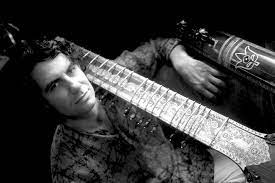By Anderson Isiagu, December 30, 2019
On Wednesday October 30th, 2019, at the Drinkward Recital Hall, Harvey Mudd College, Paul Livingstone presented an Indian music concert as part of the Ken Stevens ’62 Founding Class Concert series. Livingstone presented an evening Raga, which he performed on the Sitar, in collaboration with Abhijit Banerjee on the Tabla. The atmosphere at this concert could be described as serene and meditative, it could be likened to a feeling of being transported out of the physical realm. Livingstone started his performance with a tuning session, which took place simultaneously with the tabla player. He then stopped to address the audience and to give a brief detail of what to expect in the performance. He announced the raga the performance would be based on, described the structure of the music and thanked his host. The performance was in two parts with up to two themes each in their respective gat or metered sections. The music started with the sound of a constant drone. Drones have typically been left to the tanpura, however, modern developments brought about the use of a shruti box and, in the case of Livingstone’s performance, an iPad. What followed is the exploration of the spirit of the raga, a section known as the alap. This features emphasis on the pitch D, same as the drone. This initial exploration establishes D as the tonal center and subsequently playing other melodic figurations that form part of the core raga pitches. The alap lasted for about 30 minutes before intermittent tabla strikes made their entry to signal the begin of the gat or metered section. The metered section featured sitar flourishes, pitch bends, tremolos, microtones, alternation between the sitar and table, and rapid iterations by the tabla that end in loud strokes. I was particularly fascinated by the ability of Mr. Livingstone to produce multiple ornate figurations using body movements. The performance seemed largely improvised, but visibly centered around a melody of some specific groups of pitches. The raga is grounded by a sixteen-beat tala known as tintal. One impressive point to note here is that both Livingstone and Banerjee met on the same day for this performance and hadn’t known each other before then. Perhaps the prescriptive nature of both Hindustani and Carnatic music as well as acceptable performance practice templates played a role in helping them marshal their technical know-how in synchronizing the performance to make it appear as though they have had numerous rehearsals. The ebb and flow of the performance, characterized by loud bursts and contrasting, almost quiet, softer sections, amplify the emotional landscapes of this meditative musical genre. However, a few notable portions of the performance were wrought with mistakes that would have escaped the attention of untrained and unmusical audience members. There were times when Mr. Livingstone expected specific patterns from the tabla and had to exert himself and use bodily gestures to signal for the correct pattern. Other mistakes include climactic moments that did not happen as expected because the two instruments were a bit off on the strong beat. In conclusion, this performance was an artist’s expression of the unseen workings of the mind on their instrument. The sitar, aided by the tabla, took its audience through the sort of emotional, meditative rollercoaster that could leave one wanting for me. That was the feeling when, after a long flurry of rapid improvisations and complex tabla rhythms, the music came to an end on a mellow and subdued note.





2 Responses
I can’t help but feel that this is the kind of work that will stand the test of time. There’s a timeless quality to your writing that transcends trends and fads. It’s the kind of piece that people will look back on years from now and still find meaning in.
This is the kind of writing that invites you to slow down and savor every line.